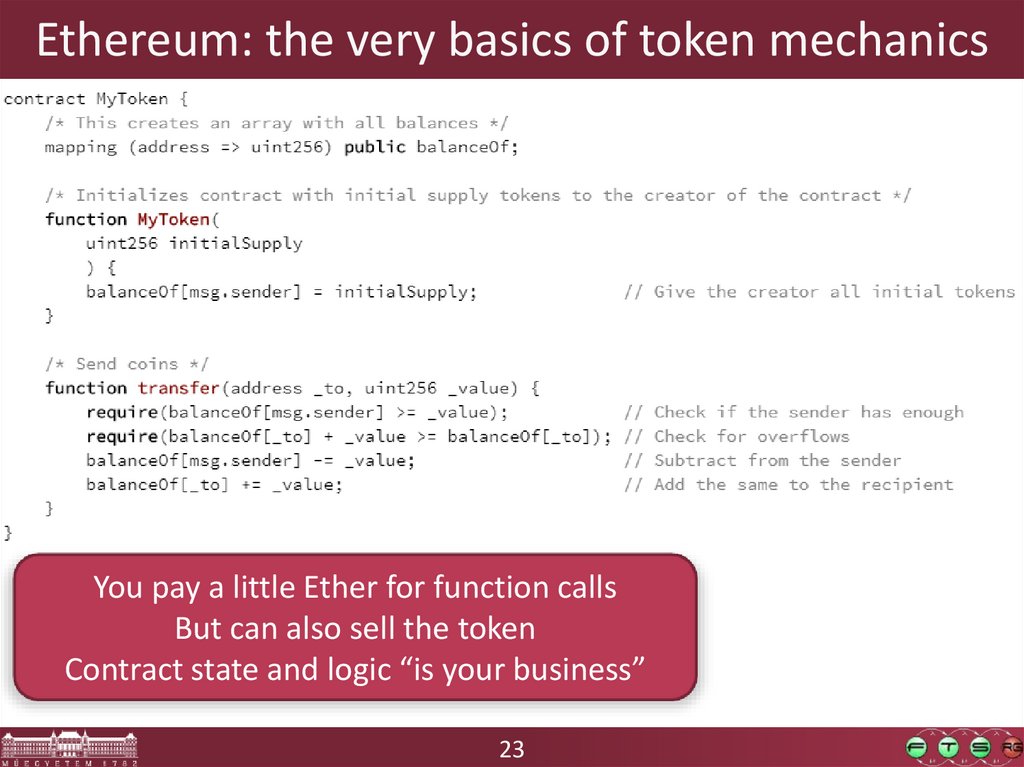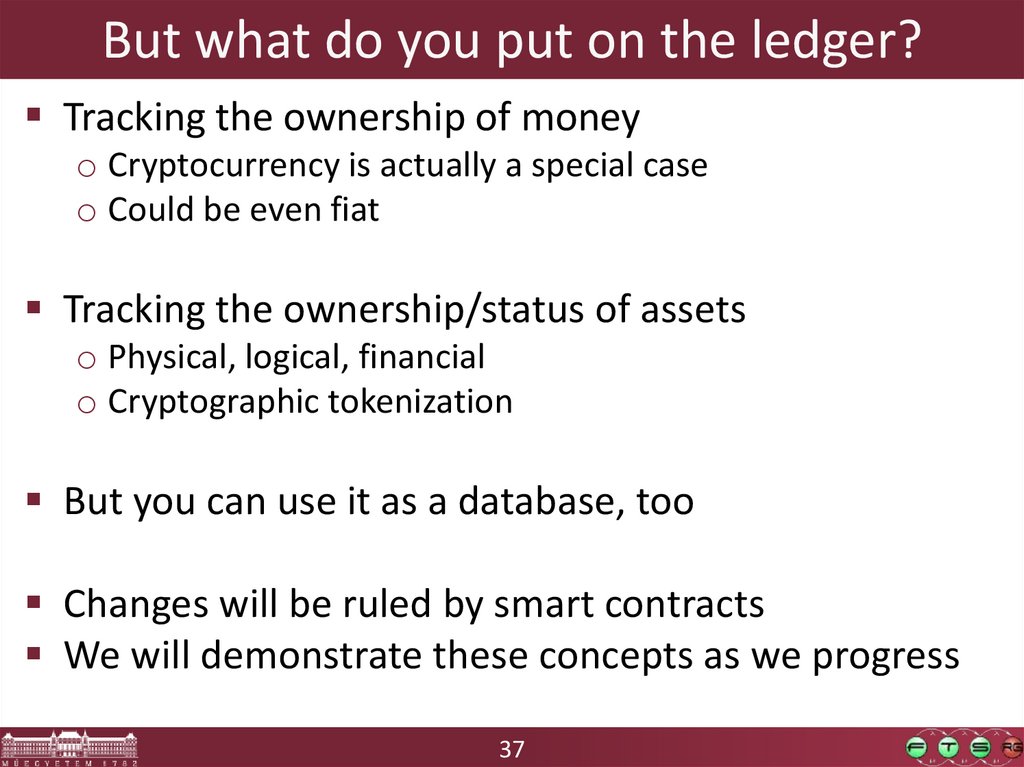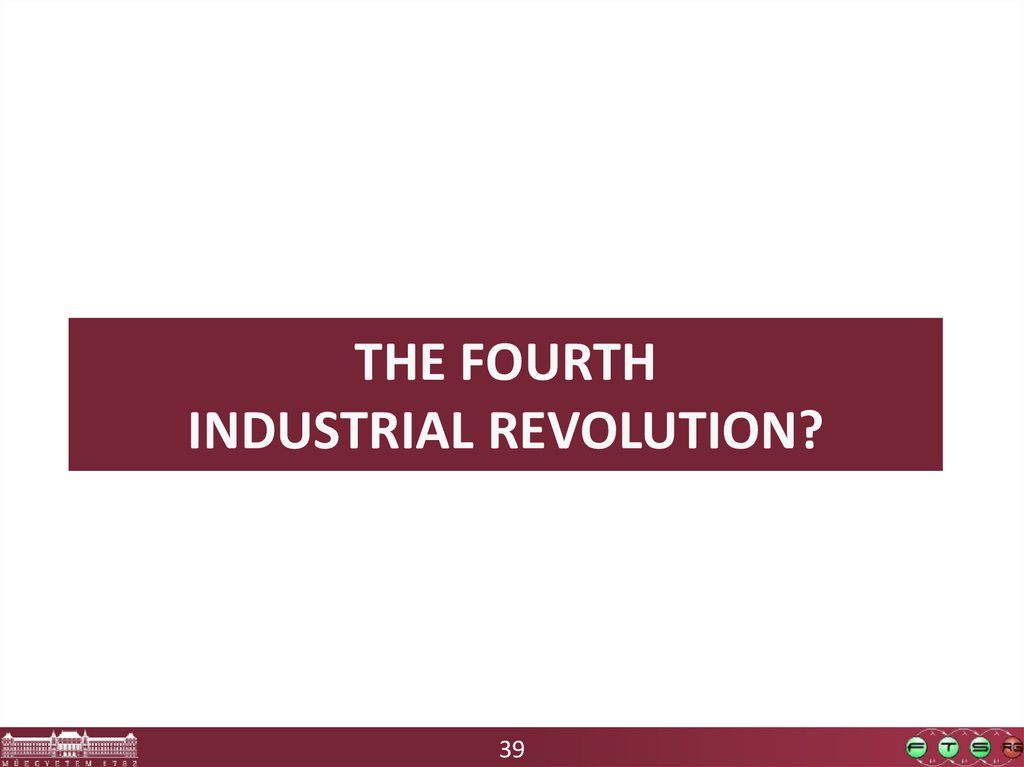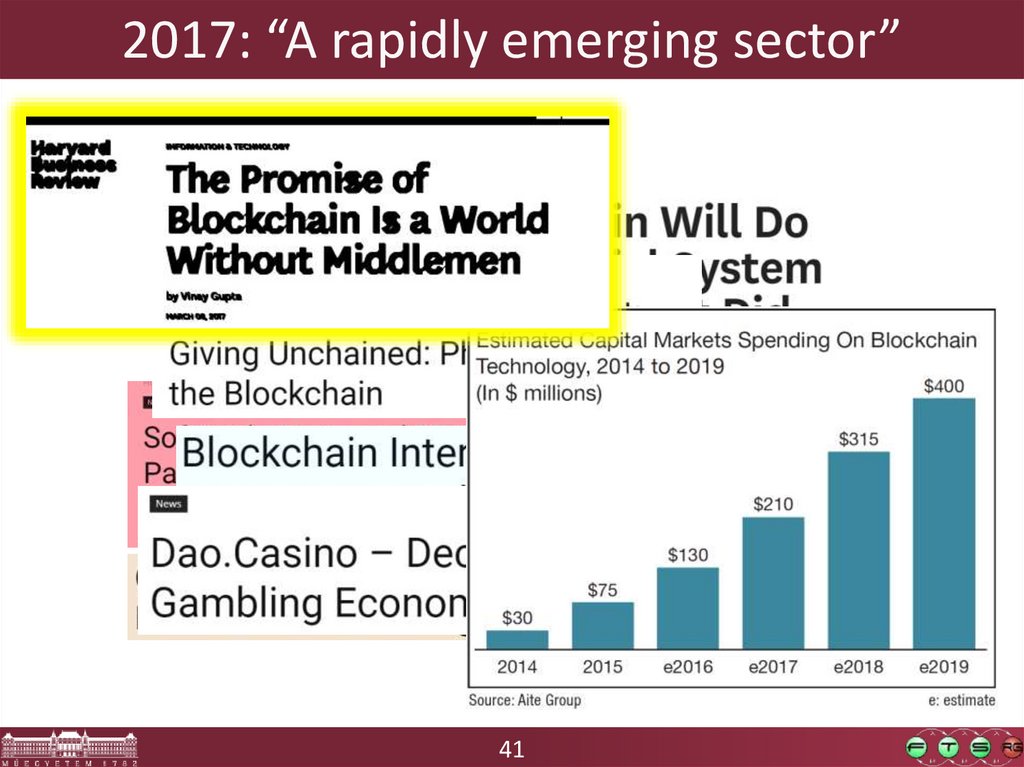Similar presentations:
Blockchain Technologies and Applications
1.
BlockchainTechnologies and Applications
Prof. András Pataricza, pataric@mit.bme.hu
Dr. Imre Kocsis, ikocsis@mit.bme.hu
2020.02.13
Budapest University of Technology and Economics
Fault Tolerant Systems Research Group
Budapest University of Technology and Economics
Department of Measurement and Information Systems
1
2.
2Blockchain@FTSRG
• 2016 IBM Faculty Award (Prof. Pataricza András)
– Teljesítménymodellezés és –elemzés, Duke kooperáció
• Linux Foundation Hyperledger: associate membership
• Kocsis Imre: ISO/TC 307 nemzeti delegált
• Hyperledger Caliper
• Hyperledger Summer Internship-ek (!)
• European Institute of Technology (EIT) Professional
School: “Blockchain for the decision maker”
2
3.
A kurzusrólNem (csak) Bitcoin – Blockchain
o A mai előadás témája
Fő oktatási célok
o Blockchain-ek rendszerszemlélete
o Nem kripto, “Distributed Ledger Technology”
o Alapvető alkalmazási esetek megismerése
o Önálló alkalmazásfejlesztés megalapozása
Választható tárgy; CS/CE csak mértékkel (~)
Tárgykövetelmény: házi feladat
3
4.
Topics we plan to cover during the course4
5.
DISTRIBUTED LEDGER TECHNOLOGY5
6.
LedgersPrincipal book of
account
Records transactions
Append-only
“Checksums”
… but really, just a Tx
log based “paper DB”
Based on: https://en.wikipedia.org/wiki/Ledger
7.
Distributed ledgers: eliminating trusted 3rd partiesDistributed ledger
Centralized
Shared,
distributed
ledger
Trusted 3rd party
7
8.
M. Rauchs et al., “Distributed Ledger Technology Systems: A Conceptual8Framework,” SSRN Journal, 2018, doi: 10.2139/ssrn.3230013.9.
Trusted 3rd parties everywhereCommunication: e.g. SWIFT
Marketplaces: exchanges, eBay
Auth. information: DNS, land
registry
Risk sharing: insurance
Democracy: election office
…
Your bank account
Good reasons for them; still,
o Centralized trust
o Middlemen have their price
o 3rd party making the rules
9
Trusted 3rd party
10.
Blockchain technologies: a DLT approach[1] Source: Marley Gray, Principle Architect PM – Microsoft: Introducing Project Bletchley
10
11.
Replacing the middleman with the groupP2P network of nodes
Block
Each peer: same ledger
o Append-only Tx log
o Hash-chained block list
• Operation
• (Validated)
Block consensus
Group consensus
o On Tx blocks
o While certain % honest
Block
• Operation
• (Validated)
Block
• Operation
• (Validated)
Block consensus
Client != peer
11
12.
Blockchain propertiesLedger: immutable Tx log; not
(just) cryptocurrency!
Smart contracts: programmed
Tx logic over ledger state
Shared: across participants
Distributed: replication
Cryptographically authentic:
non-repudiable (secure
identities), tokenization, signed
Txs
Trust: fault/attack tolerant
group consensus
12
13.
Basic transaction logicClient
request
Order, contract exec result,
acceptance: consensus
All ledgers updated
Batch processing < Blockchain latency < hard real-time
13
14.
But when you peel off the complexity…Replica
DB 1
Database
Replica
DB n
Replica
DB 2
C
Replica
DB 3
Replica
DB …
Replica
DB …
14
15.
Main differences: extra-functional!!! Properties to be understood in an “as a rule” manner
M. Rauchs et al., “Distributed Ledger Technology Systems: A Conceptual
15Framework,” SSRN Journal, 2018, doi: 10.2139/ssrn.3230013.
16.
SAME NAME, TWO(?) WORLDS16
17.
Public vs private/permissioned/consortium/…Network
Participants
Consensus
Transactions
(Bit/alt)coin
Private/
permissioned blockchain
„Not true, but a very, very good lie!”
(T. Pratchett, Nightwatch)
17
18.
Some key points(Cryptocurrency-based) public Blockchains
o Ledger based on some “unit of value”
o Peer honesty incentive: “getting more of that”
• “Mining”, Tx fees + possibly deterrents
o Bitcoin, Ethereum, Monero, Litecoin, …
o Smart contracts
• defined on and
• fueled by cryptocurrency
We discuss all these in
detail in later lectures
Private Blockchains
o Ledger: some data model
o Peer honesty
• A&A and real-world ramifications
• Value intrinsic to cooperation
o Smart contract: ledger is essentially a DB
o Hyperledger, Enterprise Ethereum Alliance, Chain Core, …
18
19.
Public example 1: Bitcoin“Ground zero” for Blockchains
Ledger: “who” has how many “coins”
P2P network: open, global (but not your closet anymore)
Tx: coin transfers
Client: anybody (pseudonymous!)
New coins: probabilistic, work-proportional peer reward
Figure: bitnodes.21.co
19
20.
Public example 2: EthereumBirds eye view: almost like Bitcoin
“Ether” instead of Bitcoin
But: you can attach code to an account
o Fuel its execution with your crypto-funds
o Have it collect/distribute Ether
o Define your own “token” in a contract
Figure: ethernodes.org
20
21.
Slight detour: Bitcoin priceAnd suddenly…
21
22.
2223.
Ethereum: the very basics of token mechanicsYou pay a little Ether for function calls
But can also sell the token
Contract state and logic “is your business”
23
24.
Some Ethereum smart contractsSource: https://parkgene.io/
24
25.
Some Ethereum smart contractsOn-chain, “programmed” claim
assessment
Long, closed, manual process
transformed into transparent
automatism
Ethereum
o Privacy?
But: risk ownership and
management not
crowd/consortium-sourced
o Could be; many startups!
Claim assessment is “only”
automated, too
Source: https://fizzy.axa/
25
26.
2627.
EthereumDecentralized autonomous organizations?
o Well… We will talk about the DAO hack
ICO: “buying into” an idea
o Business share, stake, right to use, …
Many “Initial Coin Offerings” are (were) scams
Look around!
o https://icotracker.net/
o http://www.icocountdown.com/
o…
27
28.
Cryptocurrencies: uncertain futureOn the other hand: DLT enjoys
universal support.
28
29.
Private Blockchains: asset/supply management“Small”, closed
network
Peer + client A&A
“Weighted” voting
Arbitrary Tx logic
These are intended!
You can have (asset)
tokens
But don’t have to
Ábra: IBM: Adopting Blockchain for enterprise asset management (EAM)
29
30.
A success story: MAERSK and IBMSource: https://www.ibm.com/blogs/blockchain/2018/01/digitizing-global-trade-maersk-ibm/
Both examples over Hyperledger fabric (Linux Foundation)
30
31.
Closed markets: reinsuranceSmart contract is
an important,
but small part!
http://www.chainthat.com/framework/
31
32.
Not only enterprise/business!Note: it is situational, whether the public or private model fits better
32
33.
33Egy teljesebb taxonómia
E.g., Conseil National des Greffiers des Tribunaux de Commerce:
Francia cégbejegyzések tartományok között koordinált kezelése
Zárt/”konzorciális”/”privát” hálózat
Sok, testreszabott “üzleti” hálózat
https://wiki.hyperledger.org/display/PSSIG/Public+Sector+SIG
Hyperledger, Quorum, …
Szabad részvétel a
konszenzusban
(permissionless)
Jogosult csomópontok,
szavazás-szerű (perm’d)
Energy Web Chain
“Néhány” világméretű hálózat
Ripple
“Mining” et al. helyett – 15+ éves protokollok
“Kripto”: tx díj + “ha kell”
Bitcoin, Ethereum, Zcash, …
Libra?
“Kriptopénz” léte elkerülhetetlen
Publikus hálózat
33
34.
DIGITAL ASSETSAND TOKENIZATION
34
35.
Cryptographic tokenization of assetsSource: Introducing Project "Bletchley" Marley Gray, Principle Architect PM Microsoft - Azure Blockchain Engineering
35
36.
Smart contracts over tokenized assetsSource: Introducing Project "Bletchley" Marley Gray, Principle Architect PM - Microsoft - Azure Blockchain Engineering
36
37.
But what do you put on the ledger?Tracking the ownership of money
o Cryptocurrency is actually a special case
o Could be even fiat
Tracking the ownership/status of assets
o Physical, logical, financial
o Cryptographic tokenization
But you can use it as a database, too
Changes will be ruled by smart contracts
We will demonstrate these concepts as we progress
37
38.
Some digital asset typesCryptocurrency
Central bank currency
Digital currency
Commodity-backed tokens
Equity tokens
Accounting tokens
Digital collectible
Utility tokens
https://www.coindesk.com/periodic-table-blockchain-classify-tokens/
38
39.
THE FOURTHINDUSTRIAL REVOLUTION?
39
40.
Industrial revolutions1st: urbanization, steam engine
2nd: steel, oil, electricity, internal combustion engine
3rd: digitization, ICT, Internet
4th: technology embedded within societies
o DLT is identified as a key component
We’ve never had this capability before – trusted transactions
directly between two or more total strangers, authenticated
by mass collaboration, and powered by collective selfinterests, rather than by corporations motivated by profit or
governments motivated by power.
Source: World Economic Forum: Realizing the Potential of Blockchain, June 2017.
40
41.
2017: “A rapidly emerging sector”41
42.
4243.
Blockchain project ecosystemhttps://news.blackmooncrypto.com/
the-blockchain-ecosystem-v3-six-monthsafter-the-hype-ca14e9879001
43
44.
A NOTE ON PERFORMANCE44
45.
CryptoKitties!45
46.
Public Blockchain: performanceThroughput
Latency: variance
Price: variance
46
47.
Private Blockchain performanceHL fabric v0.6
Due to blocks:
still latency and
size limits, but
Tunable
Plannable
Protectable
v1.x: 3000 Tps
and beyond
47
48.
Topics we plan to cover during the course48
















































 education
education








